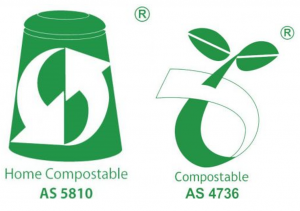Have you been wondering about the state of the nation when it comes to compostable cups?
Some are commercially compostable, while others are certified home compostable. What’s more, the terminology around cup linings can be confusing, too. From PE linings to PLA linings, and, the latest type, aqueous coatings.
Paper cups and their ability to be recycled or composted is an ever-changing field. Cup manufacturers are constantly tweaking their processes to keep up with the latest compliance requirements. Below, we endeavour to answer some of the most frequently asked questions we hear from our customers.
What are paper hot cups lined with?
Currently, in Australia, paper hot cup linings include:
- PE (polyethylene plastic) coating – not currently recycled in kerbside recycling programs.
- PLA (polylactic acid) – a plant-based plastic coating that is compostable in a commercial facility.
- Aqueous coating – a water-based coating certified home-compostable to AS5810.
Are coffee cups recyclable in Australia?
The recyclability of coffee cups is often held in contention. In Australia, no matter what they’re lined with, coffee cups are not accepted in kerbside recycling programs. This is due to contamination with food and a lack of facilities equipped to deal with managing that contamination. Coffee cup lids also aren’t recyclable for the same reason. However, there are now compostable sugarcane/bagasse lids available that suit our entire cup range. You can check out eco-friendly lids here.
What is the difference between biodegradable and compostable?
You might be surprised to learn that there can be huge differences between the eco credentials of a product marked biodegradable versus one that is home compostable.
The term biodegradable can simply mean that a product will break down into millions of tiny pieces. This is great if the product is made from organic materials, such as sugarcane or paper, and is disposed of in a compost bin. However, if the product is made of plastic, breaking it down into millions of pieces creates microplastics, and these can stay in landfills (or worse, the ocean!) for hundreds of years, creating an even bigger environmental nightmare than a non-biodegradable plastic product that stays intact.
A compostable item is something that will disintegrate into non-toxic, natural elements. Compostable items are categorised as either commercially/industrially compostable or home compostable.
How is commercial composting different from home composting?
Commercially compostable products are designed to be broken down under industrial/commercial composting conditions. These facilities accelerate the decomposition of organic matter using a variety of techniques. At the end of the process, the compostable materials become a nutrient-rich soil that can be used to help grow more fruit and vegetables. Industrial composting is a commercial enterprise that turns organic waste into a usable commodity.
Home composting is like commercial composting in that it returns organic matter to the earth. However, it’s on a much smaller scale because it happens in your backyard compost bin. It also takes longer for products to decompose because a home compost bin cannot achieve the high or consistent levels of heat obtainable in a commercial facility.
Most quality paper cups (like the ones you’ll find at Sydney Packaging) feature their eco credentials on the outside of the cup or underneath it. So, check the cup to see if it’s labelled as commercially compostable or home compostable.
Products marked with the Compostable AS4736 logo can only be broken down in industrial/commercial composting facilities. Products marked with the Home Compostable AS5810 logo can be placed in a home compost bin, a worm farm or buried in the soil to be broken down in a matter of weeks..

How long will it take my home compostable cup to break down?
A home compostable cup can be placed in a backyard worm farm, garden bed or traditional compost bin. Home composts must have ideal microorganisms, temperatures, and moisture to break down their contents. The average certified home compostable cup takes 12 weeks to completely break down in a home compost environment.
Which is the most eco-friendly disposable paper cup on the market?
Right now, in Australia, aqueous-lined cups are the most eco-friendly solution currently on the market. An aqueous cup is a paper cup lined with a water-based dispersion coating. This coating creates a barrier on the cup that prevents liquid from seeping through and makes the cup more durable. Cups with an aqueous coating are often considered to be a more eco-friendly solution because they contain less material compared to other coffee cups on the market. The Truly Eco Cup range features an aqueous inner lining that is water-resistant, preventing the paper cup from getting soaked with liquid. It is a certified home compostable product, so when you’ve finished your beverage, simply compost it at home to return it to the earth.
Check out our range of Truly Eco cups here.
If you’ve got more questions about our compostable products, please reach out to our friendly team via our Contact Us page.
